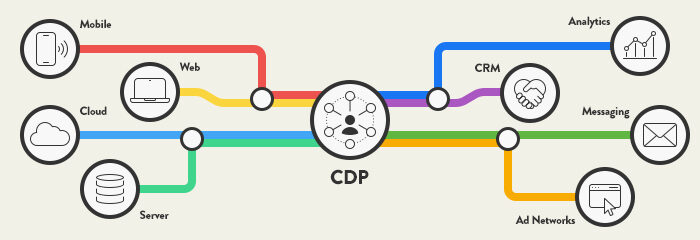
Maximizing the Use of Your First-Party Data With a Customer Data Platform (CDP)
Marketers have long used third-party cookies to track user behavior across the web and better understand different touch-points in the purchasing journey. With access to such data, they can build more accurate consumer profiles, re-target ads, and improve the overall customer experience.
Unfortunately, given the privacy concerns involved in using these tags, search engines are set to remove third-party cookies from their browsers. As brands learn to navigate a cookie-less world, many have turned their attention to first-party data. More than ever, collecting and utilising first-party data to its full potential will be vital to creating a great customer experience.
Given this change, companies like Michael Kors and Adobe have ramped up their marketing strategies by creating a customer data platform (CDP). Get to know more about what a CDP is and how you can make the most out of first-party data with it.
What Is a Customer Data Platform (CDP)?
CDPs are tools that collect customer data from a variety of touch-points, such as a website, an email, or social media platforms, and then consolidate them into a single database. This database can also be integrated into various marketing tactics and activities such as Facebook Ads, so that you can easily segment your customer base and create personalised campaigns.
Examples of data that you can aggregate with a CDP include demographics, behavioral data, transactional data, and browsing history. As you can see, CDPs primarily leverage first-party data to help you learn more about your customers and get a full picture view of them.
Value of Using CDPs for First-Party Data Management
Before the death of third-party cookies, businesses were already using first-party data. But with data becoming increasingly complex, it has become more challenging to manage it from different sources and find actionable insights. As a result, most companies use only a tiny portion of their first-party data and not many do a great job of it when they do.
CDPs address this concern by streamlining the data collection and management process. But more than this, CDPs also bring other benefits to the table. These include the following:
Get a 360° View of Your Customer
With all your first-party data unified in a single place, you can get a 360° view of your customer and engage with them at every touch-point in their journey. So instead of looking at your data in isolation, you can see the big picture and determine how to reach your customers at the right time and place.
As we all know, it’s competitive out there, so brands need to better understand their customers in order to help make a positive impact. This is made easier through CDPs since the software automatically updates your customer profiles as it collects more data. As a result, you can uncover new insights to deliver hyper-personalised experiences and stand out from other brands.
Create a Seamless Experience
With CDPs, you can give all your teams’ access to the same data, creating a seamless experience for your customers regardless of what channel they engage with.
According to research approx. 30% of consumers confirmed that they would stop buying from a brand they love after just one bad experience. This number shows how important it is to maintain a good customer experience, especially now that users are more selective about their brand interactions.
Identify New Segments
Aside from knowing your customers more comprehensively, CDPs also allow you to segment your audience and tailor your marketing efforts accordingly. While analysing your data, you might find new segments to target, which opens your brand up to potentially more revenue.
Maintain GDPR Compliance
CDPs help you stay compliant with General Data Protection Regulation (GDPR) guidelines. For one, you only use first-party data, so you can avoid the privacy issues involved in third-party tracking.
Likewise, having a single source for all your data makes it easy to manage and document consent and data flows. You can also delete Personally Identifiable Information (PII) and create Subject Access Requests (SAR) with the click of a button since everything is consolidated in the database. Without a CDP, you need to deal with several different data silos, making the job more challenging.
Best Practices for Using a CDP
With third-party cookies removed from major browsers, now is the perfect time to shift gears and turn your attention to first-party data. By using a CDP, you can maximise the use of your first-party data and take advantage of new insights while still complying with data privacy rules.
Of course, you can only reap the benefits above if you implement and use your CDP correctly. To help you achieve this, here are some best practices to follow:
- Get the whole company on board: The best way to implement a new system is to engage with all team members and get them on board. CDPs are not just valuable to your marketing or sales departments, but to the entire organisation, so you should encourage everyone to use first-party data to guide their decisions.
- Feed the right data: Ensure you understand your data and feed only the suitable types into your CDP. You can keep your customer profiles accurate and create effective targeted campaigns by filtering out unnecessary or duplicate data.
- Use online and offline data: Finally, remember that you are not limited to online sources when collecting customer data. For example, if you have physical stores, you should also include offline data in your CDP to view your customers’ shopping behavior, interests, and channel preferences.
- Identify the right metrics: You will have Key Performance Indicators (KPI’s) across most strategies being implemented, in use or being tested across your business. The same logic applies to CDPs. You should also identify what metrics help you measure CDP success. There are many possible metrics like clicks, conversions, and impressions, so the right ones ultimately depend on your goals and objectives.
The days are gone of marketers heavily reliant on third-party data to understand consumer behavior and analyse online habits. The future is set to be first-party data. Thanks to CDPs, you can now mine insights from your own gold by having a centralised database with relevant customer data.





